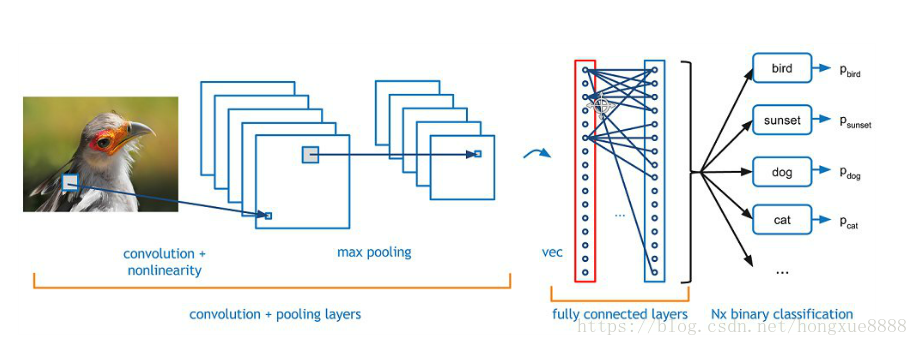卷积神经网络架构图:

一个卷积神经网络主要由5种结构组成:
- 输入层
- 卷积层
- 池化层
- 全连接层
- Softmax层
import tensorflow as tf
import random
import numpy as np
import matplotlib.pyplot as plt
import datetime
# %matplotlib inline
from tensorflow.examples.tutorials.mnist import input_data
mnist = input_data.read_data_sets("data/", one_hot=True)
tf.reset_default_graph()
sess = tf.InteractiveSession()
x = tf.placeholder("float", shape = [None, 28,28,1]) #shape in CNNs is always None x height x width x color channels
y_ = tf.placeholder("float", shape = [None, 10]) #shape is always None x number of classes
W_conv1 = tf.Variable(tf.truncated_normal([5, 5, 1, 32], stddev=0.1))#shape is filter x filter x input channels x output channels
b_conv1 = tf.Variable(tf.constant(.1, shape = [32])) #shape of the bias just has to match output channels of the filter
h_conv1 = tf.nn.conv2d(input=x, filter=W_conv1, strides=[1, 1, 1, 1], padding='SAME') + b_conv1
h_conv1 = tf.nn.relu(h_conv1)
h_pool1 = tf.nn.max_pool(h_conv1, ksize=[1, 2, 2, 1], strides=[1, 2, 2, 1], padding='SAME')
def conv2d(x, W):
return tf.nn.conv2d(input=x, filter=W, strides=[1, 1, 1, 1], padding='SAME')
def max_pool_2x2(x):
return tf.nn.max_pool(x, ksize=[1, 2, 2, 1], strides=[1, 2, 2, 1], padding='SAME')
#Second Conv and Pool Layers
W_conv2 = tf.Variable(tf.truncated_normal([5, 5, 32, 64], stddev=0.1))
b_conv2 = tf.Variable(tf.constant(.1, shape = [64]))
h_conv2 = tf.nn.relu(conv2d(h_pool1, W_conv2) + b_conv2)
h_pool2 = max_pool_2x2(h_conv2)
#First Fully Connected Layer
W_fc1 = tf.Variable(tf.truncated_normal([7 * 7 * 64, 1024], stddev=0.1))
b_fc1 = tf.Variable(tf.constant(.1, shape = [1024]))
h_pool2_flat = tf.reshape(h_pool2, [-1, 7*7*64])
h_fc1 = tf.nn.relu(tf.matmul(h_pool2_flat, W_fc1) + b_fc1)
#Dropout Layer
keep_prob = tf.placeholder("float")
h_fc1_drop = tf.nn.dropout(h_fc1, keep_prob)
#Second Fully Connected Layer
W_fc2 = tf.Variable(tf.truncated_normal([1024, 10], stddev=0.1))
b_fc2 = tf.Variable(tf.constant(.1, shape = [10]))
#Final Layer
y = tf.matmul(h_fc1_drop, W_fc2) + b_fc2
crossEntropyLoss = tf.reduce_mean(tf.nn.softmax_cross_entropy_with_logits(labels = y_, logits = y))
trainStep = tf.train.AdamOptimizer().minimize(crossEntropyLoss)
correct_prediction = tf.equal(tf.argmax(y,1), tf.argmax(y_,1))
accuracy = tf.reduce_mean(tf.cast(correct_prediction, "float"))
sess.run(tf.global_variables_initializer())
batchSize = 50
for i in range(1000):
batch = mnist.train.next_batch(batchSize)
trainingInputs = batch[0].reshape([batchSize,28,28,1])
trainingLabels = batch[1]
if i%100 == 0:
trainAccuracy = accuracy.eval(session=sess, feed_dict={x:trainingInputs, y_: trainingLabels, keep_prob: 1.0})
print ("step %d, training accuracy %g"%(i, trainAccuracy))
trainStep.run(session=sess, feed_dict={x: trainingInputs, y_: trainingLabels, keep_prob: 0.5})打印:
step 0, training accuracy 0.04
step 100, training accuracy 0.92
step 200, training accuracy 0.98
step 300, training accuracy 0.92
step 400, training accuracy 0.96
step 500, training accuracy 0.96
step 600, training accuracy 1
step 700, training accuracy 0.96
step 800, training accuracy 1
step 900, training accuracy 0.98




 本文介绍了一种使用卷积神经网络(CNN)进行MNIST手写数字识别的方法,并详细展示了从数据预处理到搭建CNN模型的具体步骤,通过训练模型实现对MNIST数据集的有效分类。
本文介绍了一种使用卷积神经网络(CNN)进行MNIST手写数字识别的方法,并详细展示了从数据预处理到搭建CNN模型的具体步骤,通过训练模型实现对MNIST数据集的有效分类。
















 1051
1051

 被折叠的 条评论
为什么被折叠?
被折叠的 条评论
为什么被折叠?








